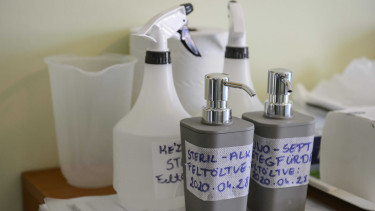Infectologist warns about possible fourth wave in coronavirus pandemic

Szlávik promotes vaccination
There is no medication coming up before the end of the year that could cure coronavirus patients effectively, which is why the focus should now be on vaccination, János Szlávik, head infectologist at the Dél-pesti Centrumkórház, said on InfoRádió. The time when we can walk the streets without wearing a face mask is on the horizon, he said, adding that the spread of the virus can only be stopped once global vaccination coverage is reached. Taking up the vaccine is important lest we risk a fourth wave, Szlávik warned.
The main points of the interview were as follows:
Those who have received both doses of a vaccine, or a single shot of a one-dose vaccine, will transmit infection with a much lower chance even if infected.
With regard to virus transmission, the focus should be on the unvaccinated, not those who have been vaccinated.
We now know that children infect others with a much lower probability. Hungary has started vaccinating children between 16 and 18, an age group highly likely to spread the virus through movement in the community. In the 12 to 16 age group, this probability is much lower, but vaccination will still be extended to groups at risk, including the obese or those with heart or lung conditions. Vaccinating children under 12 makes absolutely no sense, even if certain countries decide to do so.
Those who have recovered from the disease can be vaccinated two weeks after recovery. Others believe the time gap should be up to 12 weeks. Which vaccine is used does not matter.
Thanks to wearing masks, there was no flu season this winter, and a much lower number of pneumonia cases. Masks also prevented other pathogens from spreading from people to people. While not saying everyone should continue wearing masks in the future, Szlávik highlighted its efficiency in protection.
While masks must still be worn in several places, we can already see a future in Hungary when we can walk the streets without wearing a face mask.
There will certainly be further opening soon. The next vaccination milestone is 5 million people, which is a very high number. Although not all restrictions will be lifted, 5 million vaccinations and low daily case numbers certainly allow for further steps to open up the country.
A potential fourth wave of the pandemic would primarily be due to the high number of unvaccinated people. Anyone yet to register for a vaccine should be warned that doing so helps the entire country, as the next wave could be prevented by vaccinating as many people as possible, Szlávik said.
Mutations can find their way into society if they encounter a lot of people who have not been exposed to the coronavirus at all.
Meeting in enclosed spaces, maybe even without masks if that regulation is eased, could easily kick off a new outbreak.
The entire world is now closely watching the UK, where vaccination coverage is still below 60% and the Indian variant has appeared, looking to see if there is a higher incidence rate among those not vaccinated. The country is now a demo lab showing what happens when a new, much more virulent mutation hits a population.
Only about 8 to 10% of people everywhere take up their second dose. Whereas it sounds good that the first dose gives you a 70 to 80% immunity, it will wane extremely rapidly. Without a second (booster) shot, there will be no high immunity and you can still be infected. Your protection level will not be the same as for those that were inoculated with two doses.
The Indian variant (B.1.617) has started to spread in the United Kingdom, but according to observations none of those that were infected with it despite being vaccinated had to be hospitalised with severe symptoms. It’s good news that vaccines provide protection from the Indian variant, as well.
Pharma companies should be pre-emptive, though, and start producing vaccines that are effective against the new mutations. If they succeeded at integrating the spike proteins of most variants in a new vaccine, this new-generation vaccine, which Szlávik hopes is already being developed, would greatly increase our chances of protecting ourselves also against the new mutations by a new dose to be given in the summer or the autumn.
What about that fourth wave then?
Szlávik talked about the possibility of a fourth wave in the pandemic, and this concern is shared by others.
One of them is Balázs Pártos who posts all kinds of coronavirus-related statistics and occasionally projections – as much as the scarcity of reliable and transparent official figures allow – in relation to the pandemic on his Facebook page.
He, along with various virologists, infectologists and other experts, warned last month that the re-opening of terraces (of bars, cafés and restaurants) was premature and – coupled with further easing of the curbs, e.g. the re-opening of cinemas and theaters – could lead to a reversal of the improving epidemiological statistics (fewer new cases, fewer coronavirus patients in hospitals and on ventilators, etc.).
The first change, he said at the end of April, would look like stagnation, as the higher figures would follow or ‘sit on’ a downward trend. This would last for a couple of days or a week and is to be followed by a visible increase after 25 May. The first sign, he thinks, will be stagnation in the number of COVID-19 patients in hospitals.
The decline in the positivity rate has diminished. It did drop a lot, though, to 4.3% (18 May) from around 30% (end-March), and the 7-day rolling average is now 5.2% versus 25-27% in late March, but very few tests are performed (10,000 on Saturday, 7,000 on Sunday, 14,000 on Monday).
These are mandatory tests due to intra-hospital transfers (recovered COVID-19 patients) or mandatory tests performed by private health service providers for those that have recovered or have not contracted the virus in the first place.
Pártos notes that if there’s no marked worsening in coronavirus statistics by June 10 or 15, the vaccines will have cushioned the fall rather efficiently and a severe fourth wave in the pandemic will have been avoided.
I’ll dare to make a bolder statement in this respect in three to four weeks, not before
, he remarked.
“If we can avoid the fourth wave, at least 20,000 to 30,000 samples would need to be tested per day and the positivity rate should continue to drop. The decline of the decline in the last four to five days looks foreboding,” he added.
And now about the new charts.
The first one shows the number of people with coronavirus infection in hospitals and on ventilators between 1 May and 18 May.

The second and third charts show the ratio of COVID-19 patients in hospital to active cases and the ratio of those coronavirus patients that need mechanical ventilation to the number of COVID-19 patients in hospitals.

The third chart is for the period between 1 September 2020 and 18 May 2021.

It seems the rate of the decreases is shrinking. The number of coronavirus patients on ventilators appeared to be stagnating for a couple of days, but it dropped to 224 from 251 yesterday, but the percentage of hospitalised COVID-19 patients on ventilators just would not move from around 12%.
This might or might not be the harbinger of the fourth wave. We should know more in about 10-14 days.
Cover photo: MTI/Szilárd Koszticsák





